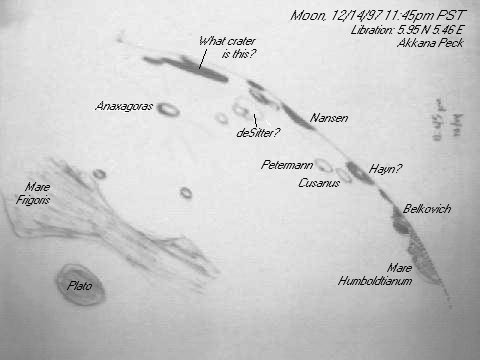
(Image quality disclaimer: I don't have a scanner, so I used an Indycam.)
(Update: I got a scanner! Here is a scan of the original.)

(Image quality disclaimer:
I don't have a scanner, so I used an Indycam.)
(Update: I got a scanner!
Here is a scan of the original.)
Last Sunday night, 12/13/97, I took advantage of a rare clear night and a good northern and eastern libration to try to find my way around the far-northern regions of the moon, using a 4.5" reflector and a low-power eyepiece.
Anaxagoras and its extensive ray system dominated the north pole area of the just-past-full moon. (I wasn't sure until later that it was Anaxagoras; Rukl doesn't show ray detail in his charts, and it's sometimes difficult to guess which of many craters might be the one showing rays. Cherrington ("Exploring the Moon Through Binoculars and Small Telescopes") came to the rescue with his labelled photos of the moon at different phases. Wouldn't it be wonderful to have a detailed lunar atlas which showed the moon in different lighting conditions?
On the eastern limb, Mare Humboldtianum showed a nice double-ring structure, like a smoothed and weathered Orientale. Belkovich wasn't visible, but its near wall showed as a mountain range on the northern end of Humboldtianum. Nearby Hayn extended its central peak up into the last rays of the setting sun.
North of Anaxagoras on the limb, a very prominent crater, already in darkness, caught my eye, and I tried to identify it. I tried tracing craters from Plato past Anaxagoras, but there were too many small craters and the area looked too different in high lighting from the way it looks in Rukl, and eventually I gave up and tried tracing up along the limb from Humboldtianum instead, skipping back and forth between Rukl's charts 4-7 and the libration chart II. Past Hayn, the prominent pair of craters must be Petermann and Cusanus, and the next major dark indentation in the limb must be Nansen. A group of large, shallow craters in a group beyond Nansen -- deSitter and Euctemon. But the crater in question was well past these, and following libration chart II and comparing distances and sizes made me think that the large crater on the limb was not actually Byrd and Peary, at the north pole, but actually past the pole, perhaps Hermite?
In doing this crater-hopping, a friend's moon globe proved very useful. I found that trying to guess orientations when triangulating between Humboldtianum and Anaxagoras was often quite misleading (it's hard to compensate correctly for the foreshortening the charts show), whereas a globe can be held at the same orientation as the moon. The only moon globe I have is the tiny 4" Replogle globe that comes in the three-globe set (earth, moon, and Mars) which I bought strictly for the Mars globe, not intending to use the other two; but even that toy was quite useful in following libration features, and I may have to consider buying a better moon globe at some point.
I made a drawing of the area in the hope of being able to identify later some of the features I saw, with the help of more charts and more sleep. I don't have a scanner, but I snapped an image with an IndyCam, did some color editing and added labels, and uploaded it here.
Rukl charts discussing these features: 7 and libration chart II.